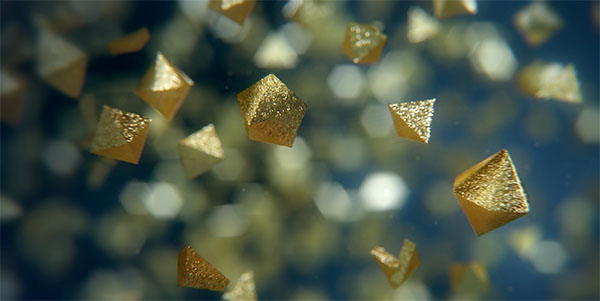| Feb 13, 2024 |
|
(Nanowerk News) Results from phase two clinical trials at UT Southwestern Medical Center showed that a suspension of gold nanocrystals taken daily by patients with multiple sclerosis (MS) and Parkinson’s disease (PD) significantly reversed deficits of metabolites linked to energy activity in the brain and resulted in functional improvements.
|
|
The findings, published in the Journal of Nanobiotechnology (“Evidence of brain target engagement in Parkinson’s disease and multiple sclerosis by the investigational nanomedicine, CNM-Au8, in the REPAIR phase 2 clinical trials”), could eventually help bring this treatment to patients with these and other neurodegenerative diseases, according to the authors.
|
 |
| Gold nanocrystals suspended in a water buffer represent a novel therapeutic agent developed by Clene Nanomedicine for neurodegenerative conditions. This nanomedicine, called CNM-Au8, is being investigated to treat patients with multiple sclerosis and Parkinson’s disease in clinical trials at UT Southwestern. (Illustration: Random 42/Source: Clene Nanomedicine)
|
|
“We are cautiously optimistic that we will be able to prevent or even reverse some neurological disabilities with this strategy,” said Peter Sguigna, M.D., who leads the active MS trial and is an Assistant Professor of Neurology and an Investigator in the Peter O’Donnell Jr. Brain Institute at UT Southwestern.
|
|
Healthy brain function depends on a continuous supply of energy to this organ’s cells through a molecule called adenosine triphosphate (ATP), Dr. Sguigna explained. Age causes a decline in brain energy metabolism, evident in a decrease in the ratio of nicotinamide adenine dinucleotide (NAD+) and its partner, nicotinamide adenine dinucleotide + hydrogen (NADH).
|
|
However, studies have shown that in neurodegenerative conditions such as MS, PD, and amyotrophic lateral sclerosis (ALS) – also known as Lou Gehrig’s disease – this decline in the NAD+/NADH ratio is much faster and more severe. Studies in cells, animal models, and human patients have suggested that halting or reversing this energy deficit could lead to a slower decline or even partial recovery for patients with neurodegenerative diseases, Dr. Sguigna said.
|
|
Toward that end, he and his colleagues partnered with Clene Nanomedicine, a company developing gold nanocrystals into an orally administered therapeutic agent for neurodegenerative conditions, including an experimental treatment named CNM-Au8. These nanocrystals act as catalysts that improve the NAD+/NADH ratio, positively altering brain cells’ energy balance – a phenomenon demonstrated in cellular and animal models in previous studies.
|
|
To determine whether CNM-Au8 was reaching its intended target in human patients, the UTSW researchers recruited 11 participants with relapsing MS and 13 with Parkinson’s for two phase two clinical trials, REPAIR-MS and REPAIR-PD. These participants received an initial brain magnetic resonance (MR) spectroscopy scan to determine their baseline NAD+/NADH ratio and the levels of other molecules associated with cell energy metabolism. After they took a daily dose of CNM-Au8 for 12 weeks, testing included a second MR spectroscopy.
|
|
Together, the 24 patients had an average increase in their NAD+/NADH ratios of 10.4% compared with baseline, showing that CNM-Au8 was targeting the brain as intended. Other energetic molecules, including ATP, normalized to the group mean by the end of treatment, another potentially beneficial effect. Using a validated survey for functional outcomes in PD, researchers found that study patients with this condition reported improved “motor experiences of daily living” at one point, suggesting that taking CNM-Au8 could ameliorate functional symptoms of their disease. None of the patients experienced severe adverse side effects linked to CNM-Au8.
|
|
While these results are encouraging, additional studies are needed, Dr. Sguigna said. REPAIR-MS will continue to enroll participants to see whether similar findings can be reproduced in progressive MS.
|
- SEO Powered Content & PR Distribution. Get Amplified Today.
- PlatoData.Network Vertical Generative Ai. Empower Yourself. Access Here.
- PlatoAiStream. Web3 Intelligence. Knowledge Amplified. Access Here.
- PlatoESG. Carbon, CleanTech, Energy, Environment, Solar, Waste Management. Access Here.
- PlatoHealth. Biotech and Clinical Trials Intelligence. Access Here.
- Source: https://www.nanowerk.com/nanotechnology-news3/newsid=64649.php




